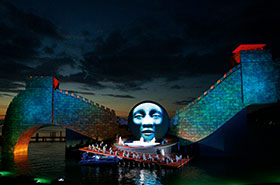

The 70-year history of the Bregenz Festival in Austria has been accompanied by a series of technical masterpieces that make watching opera on Lake Constance a memorable experience. From July to August, the floating stage on Lake Constance hosts spectacular opera performances that attract 7000 spectators each night with their combination of music, singing, state-of-the-art stage technology and effective lighting against a spectacular natural backdrop. For Giacomo Puccini’s ‘Turandot’, which takes place in China, stage designer Marco Arturo Marelli built a ‘Chinese Wall’ on the lake utilising complex stage machinery controlled by Beckhoff technology.
The tradition of the Bregenz Festival goes back to 1946, when the event started with a performance of Wolfgang Amadeus Mozart’s musical comedy ‘Bastian and Bastienne’ on two gravel barges anchored in the harbour. The space on the barges soon became too small, and the organisers decided to build a real stage on the lake, which became larger and more sophisticated as the years went by. Every two years, when the repertoire changes, the stage is completely torn down and rebuilt. This also applies to the 119 wood and steel poles that are driven up to 6 metres deep into the lake bed and carry the huge weight of the performance space. This enables the organisers to be sure that the floating stage will hold up against the forces of wind, water and flooding.
The backdrop that Marco Arturo Marelli designed for ‘Turandot’ consists of a 72 metre long wall that snakes across the stage like a giant dragon. A sophisticated structure of steel, concrete and wood holds the 29 000 pieces in place. “Since the stage weighs 335 metric tons, the structural requirements are exceptionally demanding,” says controls technician Stefan Frischke. “After all, the backdrop must be able to withstand extreme weather conditions such as thunderstorms.” When the action calls for it, the wall must also be able to collapse very effectively, which happens at the beginning of the opera when more than 200 terracotta warriors become visible behind it, appearing to be marching from the heavens into the lake.
The actual centrepiece of the floating stage is an extendable rotating portion with two additional performance areas below it. When its hinged floor opens up, it features a video wall on its underside for special visual effects using image projection.
PC-based control platform masters complex stage technology
The floating stage is also highly unique with regard to its control technology, as Frischke knows only too well: “In STB Steuerungstechnik Beck, we have found a great partner to help implement our stage control requirements, which are often very unusual.”
For Turandot, the Austrian systems integrator developed a Beckhoff-based control solution that includes the following functions:
• Control the rotating stage, which is 16 metres across, via a wire drive with various positions and end stops.
• Control various doors and hatches with position monitoring functionality.
• Collapse the wall in a controlled manner.
• Control the hydraulics for the rotating stage cover, which also functions as a video wall.
• Raise and submerge the hidden podium under the rotating stage.
A unique special effect of the stage design is a seemingly autonomous boat that circles the stage. It may look magical, but does in fact require complex technology: The boat is mounted on a scissor lift that moves on a rail system below the lake’s surface. The scissor lift alone weighs 5 tons, and the boat adds another 2,5 tons.
The stage controller consists of a panel PC as the central platform along with distributed EtherCAT I/O terminals. “Since the floating stage involves some highly unusual requirements, the flexibility of Beckhoff control technology was of critical importance for us,” says Alfred Beck, general manager of STB Steuerungstechnik. “It allows us to make changes and additions at any time and at little cost. Adding more terminals to the system is all it takes if we want to add more functionality. Another decisive factor during the selection process was the compact form factor of the Beckhoff control solution because space is always limited on a performance stage.”
For more information contact Kenneth McPherson, Beckhoff Automation, +27 (0)11 795 2898, [email protected], www.beckhoff.co.za
| Tel: | +27 11 795 2898 |
| Fax: | 086 603 6868 |
| Email: | [email protected] |
| www: | www.beckhoff.com |
| Articles: | More information and articles about Beckhoff Automation |
© Technews Publishing (Pty) Ltd | All Rights Reserved